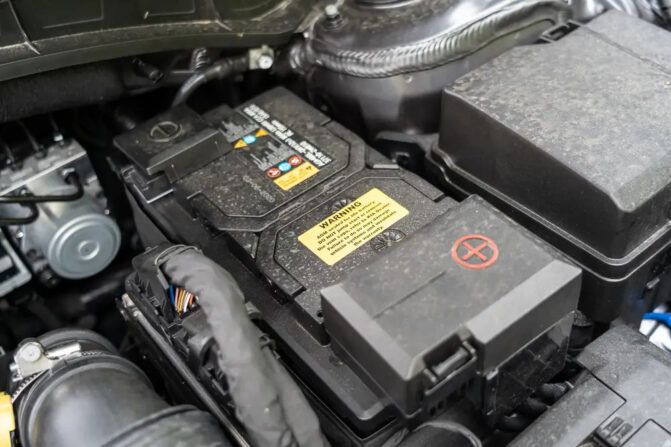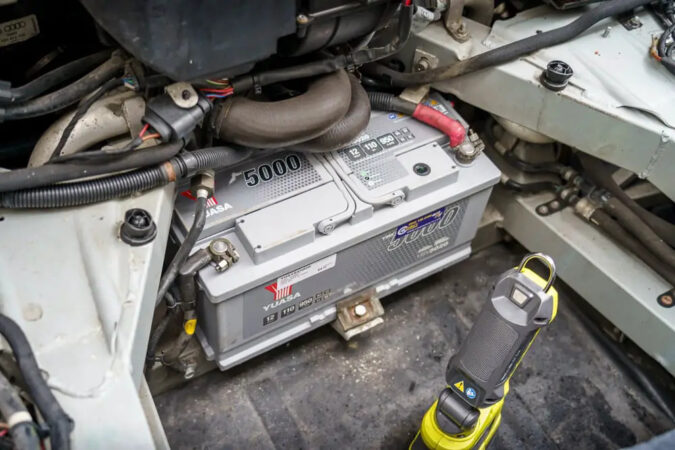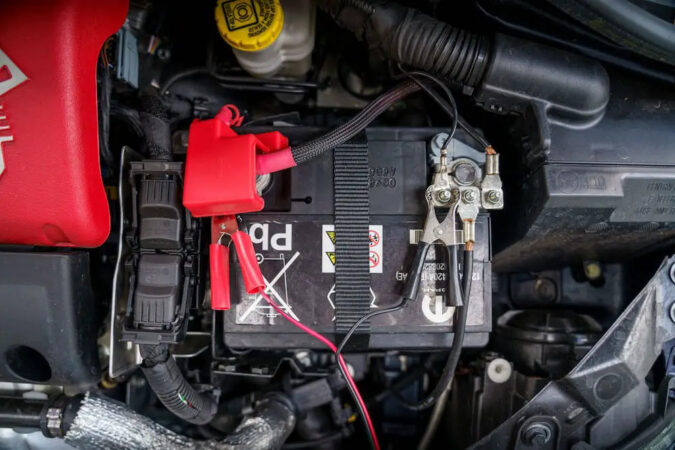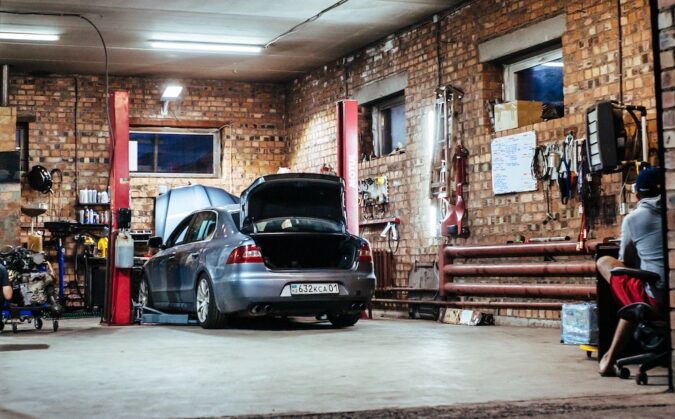What kind of battery do I need? How much should it cost? What are the car battery sizes? As car enthusiasts, we often get these questions from our friends and families. To make this easier for you—and for us, so we can just refer them here—this post will serve as your car battery guide.
From the type of battery you need, the brands, the costs, car battery sizes, and everything else in between. Batteries are very important for your car, and here’s what you should know before making a buying decision:
Car Battery
We always like to start with the basics. Of course, feel free to skip this section if you already understand how car batteries work in general. If you want to learn more, continue reading:
We’re obviously referring to the 12-volt battery that’s used to start the car, also known as the starter battery. Not the batteries in electric cars, that’s an entirely different type of battery and irrelevant here. Anyway, they’re typically made from lead acid, although there are lithium 12-volt batteries also available in the market now.
Their main job is to start the car. When you turn the ignition key (or press the starter button, if you’re keen to convert your car to push-button start), your battery will power the starter motor. This motor cranks the engine and assuming there are no faults, the engine will run.
Afterward, the engine will power the alternator through the drive belt. The alternator will produce electricity to power various electrical accessories, such as the headlights, dome light, and radio, and it recharges the battery as well so you have enough juice to crank the car on your next drive.
Very simple, right? Of course, you can learn more by watching the video above explaining how 12-volt lead-acid batteries work. It’s not too complex, but the inner workings of electronics can be a little hard to grasp since you can’t actually see them.
Aside from that, the battery acts as a reserve power storage for when the car needs it. Such as when running multiple electrical accessories at the same time. But most of the time, the alternator will do that job. The battery’s job is so simple, yet, if it doesn’t work, it might just ruin your entire day.
Car Battery Sizes Chart
Without further ado, here’s a chart of car battery sizes as determined by the Battery Council International (BCI):
| BCIGroup Number | L(inches) | W(inches) | H(inches) |
|---|---|---|---|
| Passenger Car and Light Commercial Batteries (12 Volt/6 Cells) | |||
| 21 | 8-3/16 | 6-13/16 | 8-3/4 |
| 22F | 9-1/2 | 6-7/8 | 8-5/16 |
| 22HF | 9-1/2 | 6-7/8 | 9-1/2 |
| 22NF | 9-7/16 | 5-1/2 | 8-15/16 |
| 22R | 9 | 6-7/8 | 8-5/16 |
| 24 | 10-1/4 | 6-13/16 | 8-7/8 |
| 24F | 10-3/4 | 6-13/16 | 9 |
| 24H | 10-1/4 | 6-13/16 | 9-3/8 |
| 24R | 10-1/4 | 6-13/16 | 9 |
| 24T | 10-1/4 | 6-13/16 | 9-3/4 |
| 25 | 9-1/16 | 6-7/8 | 8-7/8 |
| 26 | 8-3/16 | 6-13/16 | 7-3/4 |
| 26R | 8-3/16 | 6-13/16 | 7-3/4 |
| 27 | 12-1/16 | 6-13/16 | 8-7/8 |
| 27F | 12-1/2 | 6-13/16 | 8-15/16 |
| 27H | 11-3/4 | 6-13/16 | 9-1/4 |
| 29NF | 13 | 5-1/2 | 8-15/16 |
| 33 | 13-5/16 | 6-13/16 | 9-3/8 |
| 34 | 10-1/4 | 6-13/16 | 7-7/8 |
| 34R | 10-1/4 | 6-13/16 | 7-7/8 |
| 35 | 9-1/16 | 6-7/8 | 8-7/8 |
| 36R | 10-3/8 | 7-1/4 | 8-1/8 |
| 40R | 10-15/16 | 6-7/8 | 6-7/8 |
| 41 | 11-3/16 | 6-7/8 | 6-7/8 |
| 42 | 9-5/16 | 6-13/16 | 6-13/16 |
| 43 | 13-1/8 | 6-7/8 | 8-1/16 |
| 45 | 9-7/16 | 5-1/2 | 8-15/16 |
| 46 | 10-3/4 | 6-13/16 | 9 |
| 47 | 9-11/16 | 6-7/8 | 7-1/2 |
| 48 | 12-1/16 | 6-7/8 | 7-9/16 |
| 49 | 15 | 6-7/8 | 7-3/16 |
| 50 | 13-1/2 | 5 | 10 |
| 51 | 9-3/8 | 5-1/16 | 8-13/16 |
| 51R | 9-3/8 | 5-1/16 | 8-13/16 |
| 52 | 7-5/16 | 5-13/16 | 8-1/4 |
| 53 | 13 | 4-11/16 | 8-1/4 |
| 54 | 7-5/16 | 6-1/16 | 8-3/8 |
| 55 | 8-5/8 | 6-1/16 | 8-3/8 |
| 56 | 10 | 6-1/16 | 8-3/8 |
| 57 | 8-1/16 | 7-3/16 | 6-15/16 |
| 58 | 10-1/16 | 7-3/16 | 6-15/16 |
| 58R | 10-1/16 | 7-3/16 | 6-15/16 |
| 59 | 10-1/16 | 7-5/8 | 7-3/4 |
| 60 | 13-1/16 | 6-5/16 | 8-7/8 |
| 61 | 7-9/16 | 6-3/8 | 8-7/8 |
| 62 | 8-7/8 | 6-3/8 | 8-7/8 |
| 63 | 10-3/16 | 6-3/8 | 8-7/8 |
| 64 | 11-11/16 | 6-3/8 | 8-7/8 |
| 65 | 12-1/16 | 7-1/2 | 7-9/16 |
| 70 | 8-3/16 | 7-1/16 | 7-11/16 |
| 71 | 8-3/16 | 7-1/16 | 8-1/2 |
| 72 | 9-1/16 | 7-1/16 | 8-1/4 |
| 73 | 9-1/16 | 7-1/16 | 8-1/2 |
| 74 | 10-1/4 | 7-1/4 | 8-3/4 |
| 75 | 9-1/16 | 7-1/16 | 7-11/16 |
| 76 | 13-1/8 | 7-1/16 | 8-1/2 |
| 78 | 10-1/4 | 7-1/16 | 7-11/16 |
Okay, so now you’ve seen the chart. But how do you know which one you need for your car?
Common Car Battery Sizes
Your car’s battery group size can be found in the battery section of the owner’s manual. If you don’t have the owner’s manual, type in your car’s make, model, year, and trim level and add ‘owner’s manual’. Then the search result should show a manual that’s been uploaded, assuming the car’s common enough for someone to do that.
If you don’t know the trim level, add the engine size (some cars have different engines that use different battery sizes, which also determines how much does a car battery weigh). Or you can also ask in forums. Anyway, here are some common car battery sizes:
- Many General Motors vehicles use size 75, 34, and 78 batteries.
- Large Fords, as well as Lincoln, often use 65 car battery size.
- Many Japanese cars, including Honda, Nissan, and Toyota use 35 car battery size.
- Chrysler vehicles often use size 34, and sometimes 78 car battery sizes.
Of course, we still recommend checking with your owner’s manual before you go ahead and purchase a battery. Also, you probably noticed that the difference between some sizes is very minimal. And yes, in some cases you can use them interchangeably, provided that they:
- Fit in your car’s battery compartment with the correct terminal orientation.
- Meets the specification requirement of your car’s make and model.
If you can’t find the exact battery size for your car, then you can use the closest one as long as they meet the two requirements above.
Car Battery Shopping Guide
Okay, now you know what size to get. But before you go out and shop, here are a few more things you should know about:
Types Of Batteries
The next thing you should know is the types of batteries available for cars. Most cars use lead-acid 12-volt batteries, and there are two main types:
- Flooded or wet cell battery. These batteries require you to top them up with distilled water for maintenance. The frequency varies, and you’ll need to check the water level in the battery cells regularly. The upside is that they can last longer than dry cell batteries if maintained properly.
- Dry cell battery has several different types, such as Valve Regulated Lead Acid (VRLA), Sealed Lead Acid (SLA), and Absorbed Glass Mat (AGM). This refers to their construction, which you don’t really need to know about. All you need to know is that they’re maintenance-free.
Each has more variations, but we believe it’s enough for you to know the two main types. If your car comes or currently has a wet cell battery, you can switch to a dry cell just fine. Provided that you purchase one with the right specs for your car.
The lithium-ion starter battery is also becoming a popular option, but mostly in high-end sports cars and supercars. They typically last longer, with some manufacturers claiming up to six years of battery life.
However, if your car comes with lead acid, we recommend sticking to that as lithium-ion may actually break your car’s electrical system. You don’t need us to tell you that will be a very costly repair job. Especially, when compared to how much is a car battery at AutoZone.
Car Battery Amps
The next thing you should know about is the car battery amps, especially how many amps is a 12-volt car battery, of which there are two:
- Cranking Amps (CA) is the measure of how many amps can be delivered for 30 seconds at 32°F.
- Cold Cranking Amps (CCA) is the number of amps it can deliver for 30 seconds at 0°F.
As usual, you should get a battery with the CA that’s recommended by the owner’s manual. But you’ll want to pay particular attention to the CCA if you live in cold climates. It’s harder for a battery to deliver power in freezing cold conditions, hence you need a battery with a high CCA to ensure it can start the engine.
So, the colder the weather, the bigger CCA you should get. Usually, 3oo to 500 CCA will do the job just fine, even at 32°F. But if you find that this is not enough or you live somewhere that’s colder than the North Pole, then a 600-CCA battery should give you enough power for flawless cold weather starts.
Otherwise, you might be experiencing the symptoms of a weak car battery. Elsewhere, you might instead have to diagnose a bad alternator vs a bad battery.
Best Car Battery
So, that’s all well and good, but what brand should you buy? Also, what is the best car battery brand? Which brand makes the best car battery? Here are a few brands you can consider (which also delve into how much is a car battery):
- Optima Batteries RedTop. The best overall choice for almost any car. Reasonable prices and their product range gets above four stars on average on Amazon. The price is around $200 to $300, with a CCA rating of up to 800 amps depending on model size.
- Odyssey Extreme. A bit pricey and can cost up to $400. But this is a great option for large trucks and SUVs, with a CCA rating of up to 950 amps.
- ACDelco Gold. This is also another highly rated AGM battery, with a reasonable price usually ranging between $180 to $280. Certain sizes have up to 770 CCA, and it’s been noted as a good option for vehicles with a stop-start system.
- XS Power D3400. In case one of you has or is thinking about upgrading your sound system, this one’s recommended by The Drive. It’s a little pricey but offers 1,000 amps to power those speakers.
- Bosch Platinum. Bosch claims it has a 2x longer life, with extreme heat and cold reliability. It’s also quite pricey at around $280, but for those who live in extreme climates, this is worth considering.
Those are some of the best car batteries that we recommend you take a look at. Other brands you should consider also include Delphi and DieHard. Happy shopping!
Other Buying Tips
So, those are the main things you should know about when buying a battery, along with some car battery brand recommendations. But here are a few more things to keep in mind:
- If you’re buying from a store and not online, check the age code. The letter indicates the month, and the number indicates the year. The newer, the better. As batteries will degrade over time regardless of whether they’re being used or not.
- Check the reserve capacity (RC). This is the amount of time the battery can supply minimum voltage to keep the car running should you have alternator issues. This should also be matched to the manufacturer’s recommendations.
Additionally, consider getting a trickle charger (our list of the best battery charger has plenty of options) if you often leave your car for a long period. If you often go on work trips and your car idles for more than a week at a time, using a trickle charger will prevent your battery from going flat.
This will allow you to start the car when you come back. Additionally, letting the battery go flat will reduce its lifespan. While you can still recharge and use it, you won’t get its optimum lifespan. If you need to learn more, head over to our extensive overview of how long does it take to charge a car battery.
Car Battery Maintenance
Right, now you’ve probably bought and installed your new car battery (with some consideration of how long does a car battery last). Or at least, know which one to buy. Also, if you want to change the battery yourself, we have a great guide on how to replace a car battery, but we digress.
Anyway, here are the things that you should know about maintenance to ensure that you get your battery’s full lifespan:
Dry Cell Batteries
Yes, we did say that dry cell batteries such as AGM don’t require any maintenance. And that’s true, but regardless of your battery type, there’s something that you should always do: check the voltage from the alternator with a multimeter.
The most important thing to do is to test the battery’s voltage while the engine is running. This determines whether or not the alternator is charging the battery properly. If the voltage is too low, then your battery won’t charge and you’ll have a flat battery sooner than later.
If it’s too high, then it can cause damage—which also shortens its lifespan. For more insight, check out our detailed guide on how to test a car battery.
ChrisFix’s video above is a great guide on how to check a car’s battery. Here are the steps in a nutshell:
- Connect the multimeter’s positive lead (red) to the positive battery terminal, and the ground (black) to the negative battery terminal.
- Turn on the car and let the engine run.
- The multimeter will immediately take a reading, and it should be somewhere between 13.5 to 14.5 volts.
If it’s outside that range, you’ll probably need to service or replace your alternator. We have a great guide about alternators right here. Alternators can be costly to fix or replace. But better to prevent than to fix, no?
If the alternator isn’t charging properly, your battery will go flat before its estimated lifespan. You can still charge the battery afterward and it will run like normal, but this will shorten its overall lifespan. So, to make sure you get the most out of your battery, make sure the alternator is charging properly.
Wet Cell Batteries
In addition to checking the voltage, wet cell batteries will require you to top them up with distilled water from time to time. This is why we’re not a fan of wet-cell batteries, but they may give you a longer service life. Anyway, here’s a video on how to refill the cells:
Some wet-cell batteries will typically have individual plugs for the holes, and you can simply twist them open. But in any case, refilling them is a fairly simple process and the video above will tell you everything you need to know.
Just make sure that you use distilled water, not mineral or tap water. The minerals in them can damage the cells, causing a leak and destroying your precious battery. Make sure to wear gloves and protective eyewear—the process isn’t all that dangerous, but it’s better to be safe than sorry!
Other Battery Maintenance Tips
So, those are the most crucial things when maintaining the battery: make sure to check the voltage periodically, and ensure the alternator is working well so it charges the battery properly. And of course, refill wet-cell batteries with distilled water. But before that, make sure that you also know how to safely disconnect a car battery.
We do have a few more tips on battery maintenance to optimize the battery’s service life:
- Check the battery terminals and cables at least once a year. Clean any battery terminal corrosion that may appear on the terminals to ensure the electrical systems are all working properly. Replace frayed cables if there are any.
- Drive your car at least once every three to five days to avoid the battery draining down. Additionally, take it for a 15-minute drive to ensure proper charging. Short drives can decrease the battery’s lifespan.
That’s about it. Unless you use a wet-cell battery, car batteries don’t require a lot of maintenance. The key thing is to take care of your alternator, follow our maintenance guide above, and with a little luck, your car battery will last a very long time.
When To Change Car Battery
A lot of battery brands advertise that their products can last up to 3, sometimes even 4 to 5 years. However, from our experience, we have yet to find a battery that lasts longer than 3 years.
Additionally, if your car has a stop-start system (for more context, check out our explainer on is auto start-stop bad for your engine) and you leave it on, it’s not uncommon for the battery to last less than 3 years. This is because the battery charges and discharges more often, hence why you need a high-quality intended for this use.
It is theoretically possible for a car starter battery to last up to 4 or even 5 years, but this is only achievable in optimal conditions and proper maintenance of the battery, alternator, and electrical system.
We recommend checking your battery and alternator once every 3 to 6 months. Also, pay attention to how your car cranks. If the car takes a little longer to crank, that’s a sign your battery is dying and you’ll probably need to replace it soon.
It can be hard to notice, but there’s definitely a difference. If your car seems to take longer to crank, check the crank amp, and if it’s lower than what’s rated, then it’s a good idea to change your battery. Better to change it sooner rather than to find yourself with a car that won’t start, no?
Car Battery Sizes: FAQs
Got any more questions about car battery sizes and car batteries in general? We’re here to help, here are some answers you might find helpful:
How Many Amps Is A Car Battery
Most car batteries are between 500 to 1,000 amps, although batteries in larger vehicles may exceed that. You should purchase a battery with the appropriate amp rating as suggested by your vehicle’s manufacturer. But getting a battery with a higher cold cranking amp (CCA) is a good idea if you live in cold areas.
What Does AGM Battery Mean
AGM stands for Absorbed Glass Mat. This type of battery has fiberglass mats within them that absorb the chemicals within the battery, hence the name. Unlike a wet-cell battery, you won’t have to top them up with distilled water. They’re maintenance-free but are usually more expensive, and wet-cell batteries might last longer if maintained properly.
How Many Amp Hours In A Car Battery
Most lead-acid car batteries have between 45 to 60 amp hours (mAh). Again, you should check your owner’s manual to find the appropriate spec for your car.
Are Car Batteries Universal
No. While most cars use a 12-volt battery made from lead acid, they’re not universal. They come in different sizes and amp ratings and have different terminal orientations as well. So, you’ll need to find one that can fit your specific make and model. Check your owner’s manual for the specification, or consult with a sales expert or battery service center representative.
Where To Get Car Batteries
You can buy batteries from Advance Auto Parts, Walmart, and Costco if you want to pick the battery up yourself. If you want them delivered, then Amazon is the way to go. You can have your batteries changed at Firestone, Good year, Pep Boys, and Sears. Availability may vary between outlets.
What Is Cold Cranking Amps
Cold Cranking Amps or CCA is a measure of the number of amps the battery can deliver continuously for 30 seconds at 0 degrees Fahrenheit. The larger the number, the better it will perform in cold weather. 300 to 500 CCA typically will suffice, but for extreme temperatures, you’ll need at least 600 CCA for a flawless cold weather start.
Are Car Batteries 12V
Yes, pretty much every car batteries are 12-volt lead acid battery. This is because the electrical system and components in cars are intended to run on 12 volts, hence the need for a 12-volt battery. Lead acid is the type of choice since they’re reliable and relatively cheap to manufacture.
Car Battery Sizes: Conclusion
So, those are the car battery sizes. There are actually more than the ones we’ve included in the table, but those are the most common ones you’ll find in passenger vehicles and light-duty trucks. Even certain heavy-duty trucks still use similar batteries to smaller passenger cars.
Getting a high-quality starter battery would be a good idea as they’re likely to last longer. Or at the very least, buy one that meets the specifications recommended by your car manufacturer.
Finally, here’s a tip: if you’re changing the battery at a respectable battery service center, you don’t actually need to know all this—especially if you drive a common car, such as a Toyota Camry, for example.
When you go to the battery service center, chances are they already have a database on what size batteries are available for a certain car. So, if for example, you own a 2012 Toyota Camry with the 3.5L V6, they should be able to pull up their database on the batteries that will fit.
Most car batteries will cost between $200 to $350, but some may cost a little over $400. And most battery service centers will charge between $80 to $150 for the labor cost. But replacing the battery is a fairly easy process, and we recommend doing it yourself to save costs.




